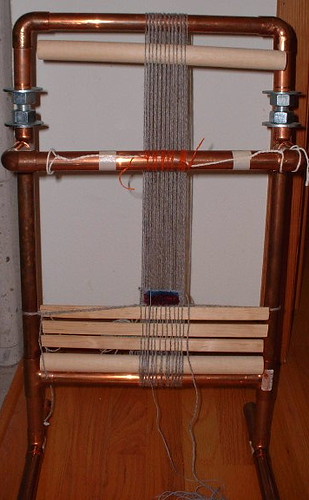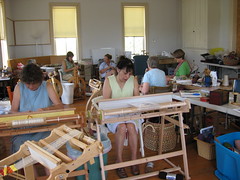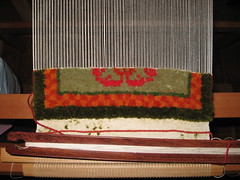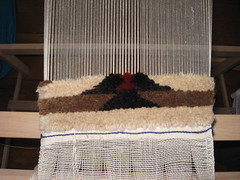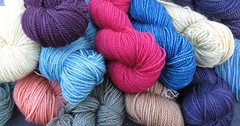When the Stars Align
Sometimes things just fall into place. I know there is preparation: you have to be ready, you have to be willing to listen, you have to be somewhat open minded.
These are hard things to align, I'm sure the stars help out. I'm also lucky (born in the Year of the Rabbit).
Just as I am finishing up a manuscript on beginning weaving, Schacht has come up with a new student loom:

This is my first handspun silk knotted pile sample on the Cricket. I am trying out the loom to see if it will be suitable for us to use this coming October at SOAR.
It is. We will.
It's a very small loom (11" x 18") and very sturdy. See those side pieces? Solid wood, strong enough to hold up under the tension required for these projects. It is small enough to work on in my lap, so it can be used semi-upright, a much more comfortable position to weave knotted pile than horizontal.
We get to be among the first to use it, and I am quite sure people will be just as impressed as I am. I'll report back in November!
Here's another view, with a bit of measurement to show the scale:

We will be switching looms for the cut pile class at SOAR this Fall. Thanks to Interweave for letting me change this particular horse midstream. Thanks to everyone who is willing to experiment, adjust and try a new way. Thanks to manufacturers for coming up with new products with just the right features, size, and strengths as if they were made just for me.
I can't believe how lucky I am to have everything drop into my lap so easily.
These are hard things to align, I'm sure the stars help out. I'm also lucky (born in the Year of the Rabbit).
Just as I am finishing up a manuscript on beginning weaving, Schacht has come up with a new student loom:

This is my first handspun silk knotted pile sample on the Cricket. I am trying out the loom to see if it will be suitable for us to use this coming October at SOAR.
It is. We will.
It's a very small loom (11" x 18") and very sturdy. See those side pieces? Solid wood, strong enough to hold up under the tension required for these projects. It is small enough to work on in my lap, so it can be used semi-upright, a much more comfortable position to weave knotted pile than horizontal.
We get to be among the first to use it, and I am quite sure people will be just as impressed as I am. I'll report back in November!
Here's another view, with a bit of measurement to show the scale:

We will be switching looms for the cut pile class at SOAR this Fall. Thanks to Interweave for letting me change this particular horse midstream. Thanks to everyone who is willing to experiment, adjust and try a new way. Thanks to manufacturers for coming up with new products with just the right features, size, and strengths as if they were made just for me.
I can't believe how lucky I am to have everything drop into my lap so easily.
